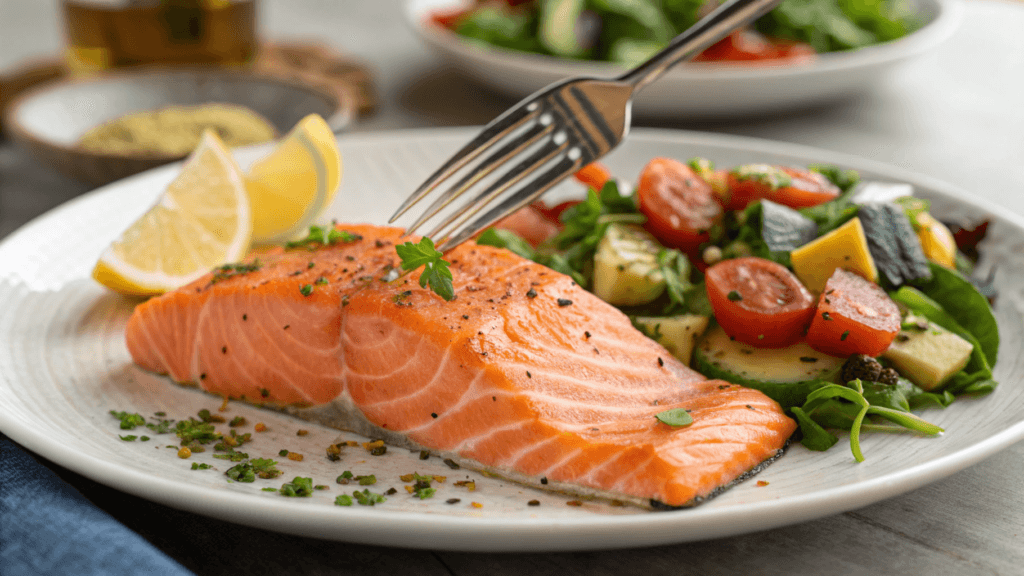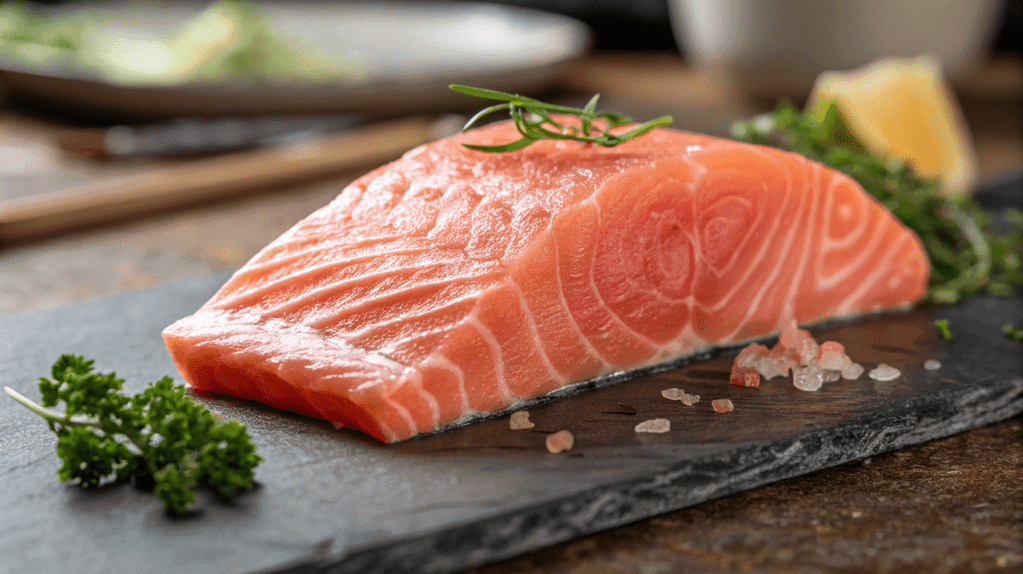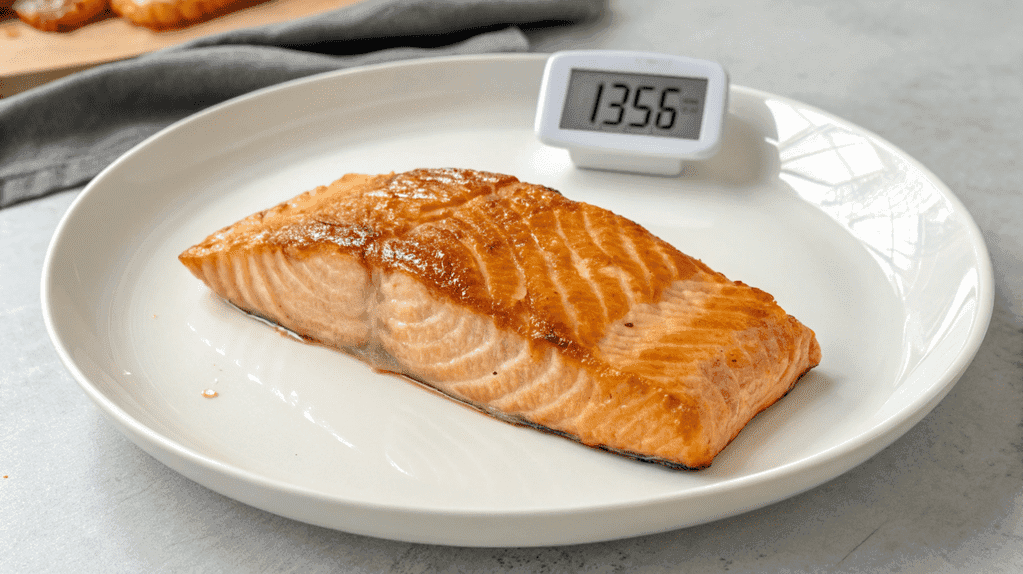Salmon is prized for its flavor and healthy omega-3s, but temperature control is key. Many ask: Can you eat salmon at 135 degrees? The USDA recommends 145°F for safety, but 135°F is often preferred for a tender, moist texture.
Understanding carryover cooking, where salmon cooks slightly after heat, helps achieve perfect results. For more tips, visit Salmon internal temp. Cooking with these insights ensures delicious salmon every time.

Table of Contents
The Science of Cooking Salmon
Cooking salmon requires careful control of heat and time to retain its delicate texture and natural moisture. Overcooking can toughen the muscle fibers, causing dryness. While 135°F is preferred for medium doneness, Is salmon done at 145 degrees? explains that 145°F is a safer internal temperature to ensure the fish is fully cooked.
The type of salmon matters as well. Wild-caught salmon is leaner and needs precise temperature control to avoid drying out, whereas farmed salmon, with its higher fat content, is slightly more forgiving. Understanding these nuances helps achieve perfectly cooked, flavorful salmon every time.
What is the USDA Recommended Temperature for Salmon?
The United States Department of Agriculture (USDA) has established guidelines for cooking fish to ensure safety. According to the USDA, all fish should be cooked to an internal temperature of 145 degrees Fahrenheit (62.8°C) to be considered safe for consumption. This temperature ensures that harmful pathogens, such as parasites and bacteria, are destroyed during the cooking process.
However, the USDA’s 145-degree recommendation is a general guideline. For certain types of fish, like salmon, some chefs and food safety experts suggest slightly lower temperatures, especially when considering the texture and quality of the fish. Understanding this nuance can help you determine whether 135 degrees is a safe and acceptable temperature for your salmon dish.

Is Salmon Safe to Eat at 135 Degrees?
Whether 135°F is safe depends on your priorities. USDA recommends 145°F for full safety, but many prefer salmon cooked to 130-135°F for a tender, moist texture. At this temperature, it remains slightly pink and translucent, ideal for medium-rare.
While 135°F doesn’t eliminate all bacteria or parasites, sourcing salmon from reputable suppliers and proper handling minimizes risks. For more details, Salmon internal temp offers helpful guidance on balancing safety and flavor.
Salmon Cooking Temperatures: A Breakdown
When it comes to cooking salmon, different temperatures yield different textures and flavors. Here’s a breakdown of various internal cooking temperatures for salmon:
- 120°F (49°C): This is a rare level of doneness for salmon, often used by chefs who prefer an almost raw center. The fish will be quite soft, tender, and slightly translucent.
- 125°F (52°C): At this temperature, the salmon is still rare but cooked slightly more than at 120°F. The center will be a bit firmer but remain moist.
- 130°F (54°C): A medium-rare doneness that many people find ideal for salmon. It is moist and tender, with a pink center.
- 135°F (57°C): Slightly more cooked than medium-rare, but still tender and juicy. The fish will be firm yet moist, with a slightly opaque center.
- 145°F (63°C): The USDA’s recommended temperature for fully cooked salmon. At this temperature, the fish will be firm and opaque throughout, though it may be drier than lower-temperature salmon.
- Over 145°F (63°C): Overcooking at temperatures above 145°F will result in dry, tough salmon.
Understanding these different temperature levels allows you to decide how to cook your salmon based on personal preference and desired texture. For those who ask, can you eat salmon at 135 degrees?—the answer is yes, but it depends on how you like your fish cooked.
Cooking Methods for Salmon
Salmon can be cooked using various methods, each contributing to the final texture and flavor. Here are some of the most popular techniques:
- Pan-Seared: A quick and effective method that creates a crispy crust on the outside while maintaining moisture on the inside. For best results, aim for a cooking temperature of 130-135°F to preserve tenderness.
- Grilled: Grilling adds a smoky flavor to the fish. When grilling, it’s crucial to monitor the internal temperature closely to avoid overcooking. Many prefer grilling salmon to 130-135°F for a balance of crispiness and moisture.
- Baked: Baking is a low-maintenance method that evenly distributes heat. Baking salmon at 350°F usually results in an internal temperature of 135°F after 15-20 minutes, depending on the thickness of the fillet.
- Poached: Poaching involves cooking salmon gently in simmering liquid, typically at around 135°F. This method helps retain moisture, making it ideal for achieving a tender, juicy result.
- Sous Vide: Sous vide is a precision cooking method that allows you to cook salmon to a specific temperature with incredible accuracy. Many sous vide recipes recommend cooking salmon at 130-135°F for the ultimate texture.
Each of these methods can help you achieve the desired result. Regardless of the technique you choose, the key is to keep a close eye on the internal temperature to avoid overcooking.
The Role of Carryover Cooking
One important factor to consider when cooking salmon at temperatures like 135 degrees is the concept of carryover cooking. Carryover cooking happens when food continues to cook after you remove it from the heat source due to retained heat. For instance, if you take salmon off the heat at 135°F, the internal temperature may rise a few degrees in the minutes following. This can be especially helpful when cooking delicate proteins like salmon, as it ensures that the fish reaches its ideal doneness without overcooking.
To minimize the effects of carryover cooking, many chefs recommend removing the salmon from the heat when it reaches about 130-135°F, allowing it to rest for a few minutes before serving. This ensures that the salmon stays tender and moist while allowing the temperature to rise slightly to a safe level.
Flavor and Texture Profiles at 135 Degrees
When you cook salmon at 135 degrees, the texture and flavor differ significantly from those at higher cooking temperatures. At this temperature, the fish remains moist, tender, and slightly flaky with a soft, buttery texture. The internal color of the salmon will be a light pink or orange hue, and the fish will be firm but not dry. The salmon retains its natural oils, which contribute to the rich flavor that many people prefer when they enjoy medium-rare doneness.
At 135°F, the salmon is still juicy, with a mild, slightly translucent center that many find ideal. The lower temperature helps preserve the delicate balance between flavor and texture, allowing the natural oils in the fish to remain intact. However, while the texture is moist, it is important to note that 135 degrees may not fully eliminate certain pathogens, particularly in lower-quality salmon. As such, proper sourcing and handling are key when cooking to this temperature.

Health Considerations: Can You Eat Salmon at 135 Degrees?
One of the most common concerns when cooking salmon at 135 degrees is whether it is safe to eat. The USDA recommends cooking fish to an internal temperature of 145°F to kill harmful bacteria and parasites. At 135 degrees, the fish isn’t fully cooked according to these guidelines, but you can still consider it safe to eat, especially if you source the salmon from a trusted supplier.
When asking, can you eat salmon at 135 degrees?, it is important to consider the quality and freshness of the fish. Properly handling and freezing the salmon before cooking reduces the risk of parasites. In addition, cooking salmon at 135 degrees allows for a medium-rare texture that retains moisture and provides a more flavorful experience. Nonetheless, people with compromised immune systems or those who are pregnant should adhere to the USDA’s higher temperature guidelines for added safety.
How to Check Salmon’s Internal Temperature
To answer the question, can you eat salmon at 135 degrees?, it’s crucial to know how to accurately check the internal temperature of the fish. The best way to do this is by using a reliable instant-read thermometer. Here are some tips on how to check the temperature correctly:
- Insert the thermometer into the thickest part of the salmon fillet, being careful not to touch the bone, which can provide inaccurate readings.
- Check the temperature after cooking and ensure the thermometer reads 135°F for a medium-rare result. If you’re aiming for a fully cooked salmon, the temperature should reach at least 145°F.
- Rest the salmon after removing it from heat. The internal temperature may rise by a few degrees during this time due to carryover cooking, which helps ensure the salmon cooks fully.
Using a thermometer is the most effective way to determine whether you can eat salmon at 135 degrees and to achieve the perfect balance of texture and safety.
Visual Cues for Doneness
In addition to checking the internal temperature, you can also use visual cues to determine if your salmon is cooked to your liking. When asking can you eat salmon at 135 degrees?, the visual cues at this temperature are crucial for understanding doneness.
- Color: At 135°F, the salmon will appear a translucent pink in the center but will be opaque at the edges. The fish should retain its natural color without becoming completely white or flaky.
- Flaking: Gently press the salmon with a fork. If it flakes easily but still holds its shape, it is most likely at the right temperature. At 135°F, the flakes will separate with minimal effort.
- Moisture: The fish should look moist, with some of its natural oils visible. Dryness or excessive flaking can indicate that you’ve overcooked the salmon.
By combining these visual cues with an accurate temperature reading, you can confidently answer the question: Can you eat salmon at 135 degrees?
Common Myths About Cooking Salmon: Can You Eat Salmon at 135 Degrees?
There are several myths surrounding the cooking of salmon that can lead to confusion, especially when trying to answer can you eat salmon at 135 degrees?. Here are some of the most common misconceptions:
- Myth 1: Salmon Must Always Be Cooked to 145°F
While the USDA recommends 145°F for food safety, many chefs and home cooks prefer cooking salmon at lower temperatures, such as 135°F, to maintain its tender texture and natural flavor. The key is ensuring proper sourcing and handling of the fish. - Myth 2: Pink Salmon is Raw or Undercooked
Pink salmon is often associated with undercooking, but this is not always the case. At 135 degrees, the pink color is perfectly normal and indicates that the fish is cooked to medium-rare. In fact, many people prefer this texture as it remains juicy and flavorful. - Myth 3: Salmon Should Not Be Cooked Rare
Cooking salmon to a rare or medium-rare state is a personal preference. As long as the fish is fresh and stored correctly, cooking it to 135°F can be perfectly safe and offer a more tender eating experience.
Understanding these myths will help you confidently decide whether can you eat salmon at 135 degrees?—and the answer is yes, for those who prefer a tender, juicy texture.
Expert Tips for Perfectly Cooked Salmon: Is It Safe to Eat at 135 Degrees?
To cook salmon to the ideal 135°F, consider these expert tips for achieving the best results:
- Start with Fresh Salmon: Always use high-quality, fresh salmon to ensure safety and flavor. If you can, buy wild-caught salmon, which is typically leaner and more flavorful.
- Don’t Overcook: If you’re aiming for a medium-rare finish, avoid overcooking your salmon. Keep an eye on the internal temperature and take the fish off the heat as soon as it reaches 135°F.
- Use the Right Cooking Method: Different methods, like pan-searing, baking, or grilling, will affect the texture of the fish. For the best results at 135°F, pan-searing and sous vide cooking are great options.
- Let it Rest: Allow the salmon to rest for a few minutes after removing it from heat. This helps the juices redistribute, resulting in a more flavorful and moist piece of fish.
By following these tips, you can cook your salmon perfectly at 135 degrees, ensuring a delicious and safe eating experience.
Frequently Asked Questions: Is Salmon Safe to Eat at 135 Degrees?
Is 135°F okay for salmon?
Yes, 135°F is fine for salmon if you prefer a moist, medium-rare texture. It preserves the fish’s flavor and tenderness, though it’s below the USDA’s 145°F guideline for safety. As long as the salmon is fresh and handled properly, it’s generally safe.
Is 135°F safe for fish?
135°F is safe for most fish, especially when properly sourced and handled. The USDA recommends 145°F, but 135°F is commonly used for a tender, juicy result, particularly for salmon. Always ensure the fish is fresh and correctly stored.
Is 130°F okay for salmon?
Yes, 130°F is acceptable for salmon if you like it medium-rare. It will be moist, tender, and slightly translucent in the center. However, for added safety, the USDA recommends 145°F.
Can you eat salmon at 130°F?
Yes, you can eat salmon at 130°F, as long as it’s fresh and properly handled. This temperature yields a medium-rare result, but if you’re concerned about food safety, stick to the USDA’s 145°F guideline.
Conclusion: Is Salmon Safe to Eat at 135 Degrees?
In conclusion, cooking salmon to 135 degrees offers a balance of safety, flavor, and texture. While the USDA recommends a higher temperature for food safety, many culinary experts argue that cooking salmon to 135°F preserves its natural oils, delivering a moist, tender, and flavorful dish. Whether you prefer your salmon medium-rare or fully cooked, understanding how to monitor internal temperatures and recognize visual cues will help you achieve the perfect result. So, next time you ask, can you eat salmon at 135 degrees?—the answer is yes, as long as you follow proper cooking practices and enjoy the rich, delicate texture that comes with this slightly lower temperature.

